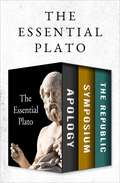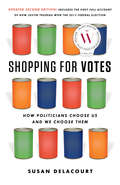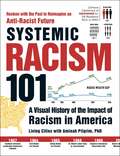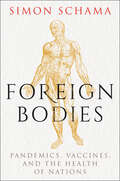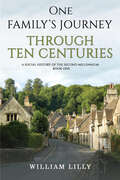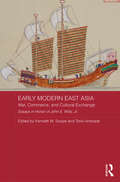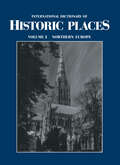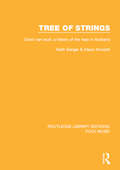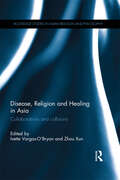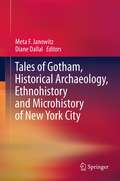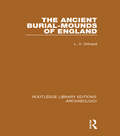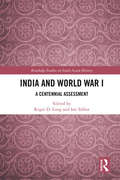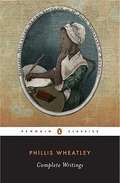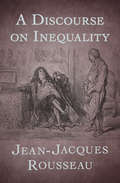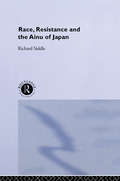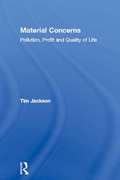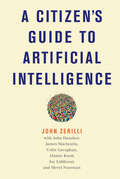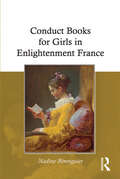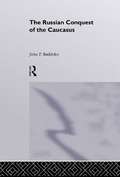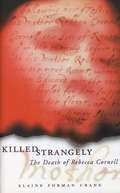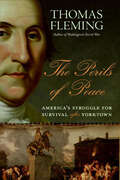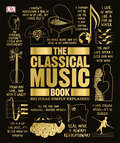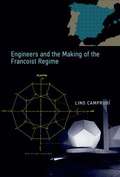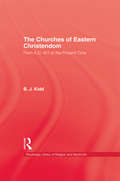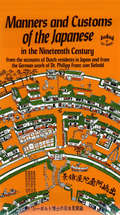- Table View
- List View
The Essential Plato: Apology, Symposium, and The Republic
by PlatoThree Socratic dialogues by the ancient Greek philosopher who established the foundations of Western thought. Apology: In this classic text, Plato recounts the trial of his mentor Socrates, who stands accused of rejecting the gods and corrupting the youth of Athens. As recounted by Plato, Socrates defends himself with a profound examination of integrity, citizenship, the nature of truth, and the role of a philosopher. Symposium: Here Plato depicts a group of Athenian intellectuals discussing the nature of desire. One after another, Agathon, Aristodemus, Eryximachus, Pausanias, and Aristophanes share their perspectives on gender, love, sexuality, and human instincts. The dialogue culminates in the radical views of Socrates, who advocates transcendence through spiritual worship. The Republic: Plato&’s magnum opus is a wide-ranging and deeply influential meditation on society as a whole. Plato explores the concept of justice, the connection between politics and psychology, the difference between words and what they represent, and the roles of art and education, among many other topics.
Shopping for Votes: How Politicians Choose Us and We Choose Them
by Susan DelacourtThis second edition offers an insightful and provocative look at the inside world of political marketing in Canada-and what this means about the state of our democracy in the twenty-first century-from a leading political commentator.Inside the political backrooms of Ottawa, the Mad Men of Canadian politics are planning their next consumer friendly pitch. Where once politics was seen as a public service, increasingly it's seen as a business, and citizens are the customers. But its unadvertised products are voter apathy and gutless public policy. Susan Delacourt takes readers into the world of Canada's top political marketers, from the 1950s to the present, explaining how parties slice and dice their platforms for different audiences and how they manage the media. The current system divides the country into "niche" markets and abandons the hard political work of knitting together broad consensus or national vision. Little wonder then, that most Canadians have checked out of the political process: less than two per cent of the population belongs to a political party and fewer than half of voters under the age of thirty showed up at the ballot box in the last few federal elections. Provocative, incisive, entertaining and refreshingly non-partisan, Shopping for Votes offers a new narrative for understanding political culture in Canada.
Systemic Racism 101: A Visual History of the Impact of Racism in America
by Living Cities Aminah PilgrimDiscover how—and why—Black, Indigenous, and people of color in America experience societal, economic, and infrastructural inequality throughout history covering everything from Columbus&’s arrival in 1492 to the War on Drugs to the Black Lives Matter movement.From reparations to the prison industrial complex and redlining, there are a lot of high-level concepts to systemic racism that are hard to digest. At a time where everyone is inundated with information on structural racism, it can be hard to know where to start or how to visualize the disenfranchisement of BIPOC Americans. In Systemic Racism 101, you will find infographic spreads alongside explanatory text to help you visualize and truly understand societal, economic, and structural racism—along with what we can do to change it. Starting from the discovery of America in 1492, through the Civil Rights movement, all the way to the criminal justice reform today, this book has everything you need to know about the continued fight for equality.
Foreign Bodies: Pandemics, Vaccines, and the Health of Nations
by Simon SchamaA vibrant cultural history investigating the tangled and complex history of pandemics and vaccines, by bestselling author and historian Simon SchamaCities and countries engulfed by panic and death, desperate for vaccines but fearful of what inoculation may bring. This is what the world has just gone through with Covid-19. But as Simon Schama shows in his epic history of vulnerable humanity caught between the terror of contagion and the ingenuity of science, it has happened before. Characteristically, Schama’s message is delivered through gripping, page-turning stories set in the eighteenth and nineteenth centuries: smallpox strikes London; cholera hits Paris; plague comes to India. Threading through the scenes of terror, suffering and hope – in hospitals and prisons, palaces, and slums – are an unforgettable cast of characters: a philosopher-playwright burning up with smallpox in a country chateau; a vaccinating doctor paying house calls in Halifax; a woman doctor in south India driving her inoculator-carriage through the stricken streets as dead monkeys drop from the trees. But we are also in the labs when great, life-saving breakthroughs happen, in Paris, Hong Kong, and Mumbai. At the heart of it all is an unsung hero: Waldemar Haffkine, a gun-toting Jewish student in Odesa turned microbiologist at the Pasteur Institute, hailed in England as “the saviour of mankind” for vaccinating millions against cholera and bubonic plague in British India while being cold-shouldered by the medical establishment of the Raj. Creator of the world’s first mass production line of vaccines in Mumbai, he is tragically brought down in an act of shocking injustice. Foreign Bodies crosses borders between east and west, Asia and Europe, the worlds of rich and poor, politics and science. Its thrilling story carries with it the credo of its author on the interconnectedness of humanity and nature; of the powerful and the people. Ultimately, Schama says, as we face the challenges of our times together, “there are no foreigners, only familiars.”
One Family’s Journey Through Ten Centuries: A social history of the second millennium – Book One
by William LillyWe trace one family, generation by generation, throughout the one thousand years of the second millennium. The trilogy sets the family within its social environment, describing its migration from the continent, and across England, Scotland, and Ireland to settle in the New World. From that we get a vivid picture of what affected, motivated, worried, and encouraged this Saxon family and how they coped. Since the migration of this family was typical for the time, this study is relevant to millions of people in the United Kingdom, Canada, and the United States, whose ancestors followed the same general migratory path. Book I specifically covers the feudal period in the Middle Ages (1000 – 1560), where a feudal autocrat and an avaricious pope, between them, owned and controlled everything. Throughout, the family became our witnesses to many of the historic events of the feudal period: the Battle of Hastings, Anglo-Saxon resistance, the plague, the Little Ice Age, the Great Starvation, Guilds, the building of great cathedrals and castles, and the gradual decline in the king’s power and control. In 1067 William the Conqueror appointed Honfroi de Insula de L’lle as the Dominus of the area around the feudal village of Combe, Wiltshire. He permitted Honfroi to live and build a motte and bailey castle there to assist in keeping the peace. The front image is Castle Combe as it appears today.
Early Modern East Asia: War, Commerce, and Cultural Exchange (Asian States and Empires)
by Kenneth M. Swope Tonio AndradeThis book presents a great deal of new primary research on a wide range of aspects of early modern East Asia. Focusing primarily on maritime connections, the book explores the importance of international trade networks, the implications of technological dissemination, and the often unforeseen consequences of missionary efforts. It demonstrates the benefi ts of a global history approach, outlining the complex interactions between Western traders and Asian states and entrepreneurs. Overall, the book presents much interesting new material on this complicated and understudied period. .
Northern Europe: International Dictionary of Historic Places
by Trudy RingFirst published in 1996. Routledge is an imprint of Taylor & Francis, an informa company.
Tree of strings: Crann nan teud: a history of the harp in Scotland (Routledge Library Editions: Folk Music #8)
by Keith Sanger Alison KinnairdThis is the first history of the harp in Scotland to be published. It sets out to trace the development of the instrument from its earliest appearance on the Pictish stones of the 8th century, to the present day. Describing the different harps played in the Highlands and the Lowlands of Scotland, the authors examine the literary and physical evidence for their use within the Royal Courts and "big houses" by professional harpers and aristocratic amateurs. They vividly follow the decline of the wire-strung clarsach from its links with the hereditary bards of the Highland chieftains to its disappearance in the 18th century, and the subsequent attempts at the revival of the small harp during the 19th and 20th centuries. The music played on the harp, and its links with the great families of Scotland are described. The authors present, in this book, material which has never before been brought to light, from unpublished documents, family papers and original manuscripts. They also make suggestions, based on their research, about the development and dissemination of the early Celtic harps and their music. This book, therefore, should be of great interest, not only to harp players but to historians, to all musicians in the fields of traditional and early music, and to any reader who recognises the importance of these beautiful instruments, and their music, throughout a thousand years of Scottish culture.
Disease, Religion and Healing in Asia: Collaborations and Collisions
by Zhou Xun Ivette M. Vargas-O'BryanRecent academic and medical initiatives have highlighted the benefits of studying culturally embedded healing traditions that incorporate religious and philosophical viewpoints to better understand local and global healing phenomena. Capitalising on this trend, the present volume looks at the diverse models of healing that interplay with culture and religion in Asia. Cutting across several Asian regions from Hong Kong to mainland China, Tibet, India, and Japan, the book addresses healing from a broader perspective and reflects a fresh new outlook on the complexities of Asian societies and their approaches to health. In exploring the convergences and collisions a society must negotiate, it shows the emerging urgency in promoting multidisciplinary and interdisciplinary research on disease, religion and healing in Asia. Drawing on original fieldwork, contributors present their latest research on diverse local models of healing that occur when disease and religion meet in South and East Asian cultures. Revealing the symbiotic relationship of disease, religion and healing and their colliding values in Asia often undetected in healthcare research, the book draws attention to religious, political and social dynamics, issues of identity and ethics, practical and epistemological transformations, and analogous cultural patterns. It challenges the reader to rethink predominantly long-held Western interpretations of disease management and religion. Making a significant contribution to the field of transcultural medicine, religious studies in Asia as well as to a better understanding of public health in Asia as a whole, it will be of interest to students and scholars of Health Studies, Asian Religions and Philosophy.
Tales of Gotham, Historical Archaeology, Ethnohistory and Microhistory of New York City
by Meta F. Janowitz Diane DallalHistorical Archaeology of New York City is a collection of narratives about people who lived in New York City during the seventeenth, eighteenth, and nineteenth centuries, people whose lives archaeologists have encountered during excavations at sites where these people lived or worked. The stories are ethnohistorical or microhistorical studies created using archaeological and documentary data. As microhistories, they are concerned with particular people living at particular times in the past within the framework of world events. The world events framework will be provided in short introductions to chapters grouped by time periods and themes. The foreword by Mary Beaudry and the afterword by LuAnne DeCunzo bookend the individual case studies and add theoretical weight to the volume. Historical Archaeology of New York City focuses on specific individual life stories, or stories of groups of people, as a way to present archaeological theory and research. Archaeologists work with material culture--artifacts--to recreate daily lives and study how culture works; this book is an example of how to do this in a way that can attract people interested in history as well as in anthropological theory.
The Ancient Burial-mounds of England (Routledge Library Editions: Archaeology)
by L.V. GrinsellFirst published in 1936 and rewritten in 1953, this book embodies the results of the author’s extensive researches and fieldwork. Part one considers types of barrows and dating, their building and the cult of the dead from Palaeolithic to Saxon times. A chapter is dedicated to maps and another to fieldwork in particular, while the final bit of the introductory material discussed barrow-digging from the time of the Romans to the twentieth century. Part two is the regional surveys, from Cornwall to Kent and northwards to the Scottish border.
India and World War I: A Centennial Assessment (Routledge Studies in South Asian History)
by Roger D. Long Ian TalbotWorld War I directly and indirectly caused events and social and political trends which defined the history of the world for the rest of the century, including the Russian Revolution and the rise of communism to the Great Crash of 1929 which lead to the Great Depression and the rise of Hitler and Nazi Germany. It marked a turning point in world history as the end of the historical era of European dominance and the ushering in of a period which accelerated demands for freedom and autonomy in colonial settings. India played a significant role in the war and in the Allied victory on the battlefield. This book explores India’s involvement in the Great War and the way the war impacted upon the country from a variety of different viewpoints including case studies focusing on key individuals who played vital roles in the war. The long and short term impacts of the war on different locations in India are also explored in the chapters which offer an analysis of the importance of the war on India while commemorating the sacrifices which were made. A new, innovative and multidisciplinary examination of India and World War I, this book presents a select number of case studies showing the intimate relationship of the global war and its social, political and economic impacts on the Indian subcontinent. It will be of interest to academics in the field of War Studies, Colonial and Imperial History and South Asian and Modern Indian History.
Complete Writings
by Phillis WheatleyIn 1761, a young girl arrived in Boston on a slave ship, sold to the Wheatley family, and given the name Phillis Wheatley. Struck by Phillis' extraordinary precociousness, the Wheatleys provided her with an education that was unusual for a woman of the time and astonishing for a slave. After studying English and classical literature, geography, the Bible, and Latin, Phillis published her first poem in 1767 at the age of 14, winning much public attention and considerable fame. When Boston publishers who doubted its authenticity rejected an initial collection of her poetry, Wheatley sailed to London in 1773 and found a publisher there for Poems on Various Subjects, Religious and Moral. This volume collects both Wheatley's letters and her poetry: hymns, elegies, translations, philosophical poems, tales, and epyllions--including a poignant plea to the Earl of Dartmouth urging freedom for America and comparing the country's condition to her own. With her contemplative elegies and her use of the poetic imagination to escape an unsatisfactory world, Wheatley anticipated the Romantic Movement of the following century. The appendices to this edition include poems of Wheatley's contemporary African-American poets: Lucy Terry, Jupiter Harmon, and Francis Williams. .
A Discourse on Inequality: A Discourse On The Origin Of Inequality, And A Discourse On Political Economy
by Jean-Jacques RousseauA fascinating examination of the relationship between civilization and inequality from one of history&’s greatest minds The first man to erect a fence around a piece of land and declare it his own founded civil society—and doomed mankind to millennia of war and famine. The dawn of modern civilization, argues Jean-Jacques Rousseau in this essential treatise on human nature, was also the beginning of inequality. One of the great thinkers of the Enlightenment, Rousseau based his work in compassion for his fellow man. The great crime of despotism, he believed, was the raising of the cruel above the weak. In this landmark text, he spells out the antidote for man&’s ills: a compassionate revolution to pull up the fences and restore the balance of mankind. This ebook has been professionally proofread to ensure accuracy and readability on all devices.
Race, Resistance and the Ainu of Japan (The University of Sheffield/Routledge Japanese Studies Series)
by Richard M. SiddleOnce thought of as a 'vanishing people', the Ainu are now reasserting both their culture and their claims to be the 'indigenous' people of Japan. Race, Resistance and the Ainu of Japan is the first major study to trace the outlines of Ainu history. It explores the ways in which competing versions of Ainu identity have been constructed and articulated, shedding light on the way modern relations between the Ainu and the Japanese have been shaped.
Material Concerns: Pollution, Profit and Quality of Life
by Tim JacksonMaterial Concerns offers new perspectives on key environmental issues - pollution prevention, ecological economics, limits to sustainability, consumer behaviour and government policy. The first non-technical introduction to preventative environmental management, Material Concerns offers realistic prospects for improving the quality of life.
A Citizen's Guide to Artificial Intelligence
by John ZerilliA concise but informative overview of AI ethics and policy.Artificial intelligence, or AI for short, has generated a staggering amount of hype in the past several years. Is it the game-changer it's been cracked up to be? If so, how is it changing the game? How is it likely to affect us as customers, tenants, aspiring home-owners, students, educators, patients, clients, prison inmates, members of ethnic and sexual minorities, voters in liberal democracies? This book offers a concise overview of moral, political, legal and economic implications of AI. It covers the basics of AI's latest permutation, machine learning, and considers issues including transparency, bias, liability, privacy, and regulation.
Conduct Books for Girls in Enlightenment France
by Nadine BerenguierDuring the eighteenth-century, at a time when secular and religious authors in France were questioning women’s efforts to read, a new literary genre emerged: conduct books written specifically for girls and unmarried young women. In this carefully researched and thoughtfully argued book, Professor Nadine Bérenguier shares an in-depth analysis of this development, relating the objectives and ideals of these books to the contemporaneous Enlightenment concerns about improving education in order to reform society. Works by Anne-Thérèse de Lambert, Madeleine de Puisieux, Jeanne Marie Leprince de Beaumont, Louise d'Epinay, Barthélémy Graillard de Graville, Chevalier de Cerfvol, abbé Joseph Reyre, Pierre-Louis Roederer, and Marie-Antoinette Lenoir take up a wide variety of topics and vary dramatically in tone. But they all share similar objectives: acquainting their young female readers with the moral and social rules of the world and ensuring their success at the next stage of their lives. While the authors regarded their texts as furthering the common good, they were also aware that they were likely to be controversial among those responsible for girls' education. Bérenguier's sensitive readings highlight these tensions, as she offers readers a rare view of how conduct books were conceived, consumed, re-edited, memorialized, and sometimes forgotten. In the broadest sense, her study contributes to our understanding of how print culture in eighteenth-century France gave shape to a specific social subset of new readers: modern girls.
The Russian Conquest of the Caucasus (Caucasus World)
by J. F. BaddeleyReprint of Baddeley's classic and rare account of the resistance of the North Caucasians under Shamil against the expansion of Tsarist Russia, with a new introduction by Moshe Gammer. Highly relevant to recent developments in the region.
Killed Strangely: The Death of Rebecca Cornell
by Elaine Forman Crane"It was Rebecca's son, Thomas, who first realized the victim's identity. His eyes were drawn to the victim's head, and aided by the flickering light of a candle, he 'clapt his hands and cryed out, Oh Lord, it is my mother.' James Moills, a servant of Cornell . . . described Rebecca 'lying on the floore, with fire about Her, from her Lower parts neare to the Armepits.' He recognized her only 'by her shoes.'"--from Killed Strangely On a winter's evening in 1673, tragedy descended on the respectable Rhode Island household of Thomas Cornell. His 73-year-old mother, Rebecca, was found close to her bedroom's large fireplace, dead and badly burned. The legal owner of the Cornells' hundred acres along Narragansett Bay, Rebecca shared her home with Thomas and his family, a servant, and a lodger. A coroner's panel initially declared her death "an Unhappie Accident," but before summer arrived, a dark web of events--rumors of domestic abuse, allusions to witchcraft, even the testimony of Rebecca's ghost through her brother--resulted in Thomas's trial for matricide. Such were the ambiguities of the case that others would be tried for the murder as well. Rebecca is a direct ancestor of Cornell University's founder, Ezra Cornell. Elaine Forman Crane tells the compelling story of Rebecca's death and its aftermath, vividly depicting the world in which she lived. That world included a legal system where jurors were expected to be familiar with the defendant and case before the trial even began. Rebecca's strange death was an event of cataclysmic proportions, affecting not only her own community, but neighboring towns as well. The documents from Thomas's trial provide a rare glimpse into seventeenth-century life. Crane writes, "Instead of the harmony and respect that sermon literature, laws, and a hierarchical/patriarchal society attempted to impose, evidence illustrates filial insolence, generational conflict, disrespect toward the elderly, power plays between mother-in-law and daughter-in-law, [and] adult dependence on (and resentment of) aging parents who clung to purse strings." Yet even at a distance of more than three hundred years, Rebecca Cornell's story is poignantly familiar. Her complaints of domestic abuse, Crane says, went largely unheeded by friends and neighbors until, at last, their complacency was shattered by her terrible death.
The Perils of Peace: America's Struggle for Survival After Yorktown
by Thomas FlemingOn October 19, 1781, Great Britain's best army surrendered to General George Washington at Yorktown. But the future of the 13 former colonies was far from clear. A 13,000 man British army still occupied New York City, and another 13,000 regulars and armed loyalists were scattered from Canada to Savannah, Georgia. Meanwhile, Congress had declined to a mere 24 members, and the national treasury was empty. The American army had not been paid for years and was on the brink of mutiny. In Europe, America's only ally, France, teetered on the verge of bankruptcy and was soon reeling from a disastrous naval defeat in the Caribbean. A stubborn George III dismissed Yorktown as a minor defeat and refused to yield an acre of "my dominions" in America. In Paris, Ambassador Benjamin Franklin confronted violent hostility to France among his fellow members of the American peace delegation. In his riveting new book, Thomas Fleming moves elegantly between the key players in this drama and shows that the outcome we take for granted was far from certain. Not without anguish, General Washington resisted the urgings of many officers to seize power and held the angry army together until peace and independence arrived. With fresh research and masterful storytelling, Fleming breathes new life into this tumultuous but little known period in America's history.
The Classical Music Book: Big Ideas Simply Explained (DK Big Ideas)
by DKLearn about the world&’s greatest classical compositions and musical traditions in The Classical Music Book.Part of the fascinating Big Ideas series, this book tackles tricky topics and themes in a simple and easy to follow format. Learn about Classic Music in this overview guide to the subject, great for novices looking to find out more and experts wishing to refresh their knowledge alike! The Classical Music Book brings a fresh and vibrant take on the topic through eye-catching graphics and diagrams to immerse yourself in. This captivating book will broaden your understanding of Classical Music, with:- More than 90 pieces of world-famous music - Packed with facts, charts, timelines and graphs to help explain core concepts- A visual approach to big subjects with striking illustrations and graphics throughout- Easy to follow text makes topics accessible for people at any level of understandingThe Classical Music Book is a captivating introduction to music theory, crucial composers and the impact of seminal pieces, aimed at adults with an interest in the subject and students wanting to gain more of an overview. Here you&’ll discover more than 90 works by famous composers from the early period to the modern day, through exciting text and bold graphics.Your Classical Music Questions, Simply ExplainedFrom Mozart to Mendelssohn, this fresh new guide goes beyond your typical music books, offering a comprehensive overview to classical music history and biography. If you thought it was difficult to learn about music theory, The Classical Music Book presents key information in an easy to follow layout. Explore the main ideas underpinning the world&’s greatest compositions and musical traditions, and define their importance to the musical canon and into their wider social, cultural, and historical context.The Big Ideas SeriesWith millions of copies sold worldwide, The Classical Music Book is part of the award-winning Big Ideas series from DK. The series uses striking graphics along with engaging writing, making big topics easy to understand.
Engineers and the Making of the Francoist Regime
by Lino CamprubíIn this book, Lino Camprubí argues that science and technology were at the very center of the building of Franco's Spain. Previous histories of early Francoist science and technology have described scientists and engineers as working "under" Francoism, subject to censorship and bound by politically mandated research agendas. Camprubí offers a different perspective, considering instead scientists' and engineers' active roles in producing those political mandates. Many scientists and engineers had been exiled, imprisoned, or executed by the regime. Camprubí argues that those who remained made concrete the mission of "redemption" that Franco had invented for himself. This gave them the opportunity to become key actors -- and mid-level decision makers -- within the regime. Camprubí describes a series of projects across Spain undertaken by the civil engineers and agricultural scientists who placed themselves at the center of their country's forced modernization. These include a coal silo, built in 1953, viewed as an embodiment of Spain's industrialized landscape; links between laboratories, architects, and the national Catholic church (and between technology and authoritarian control); vertically organized rice production and research on genetics; river management and the contested meanings of self-sufficiency; and the circulation of construction standards by mobile laboratories as an engine for European integration. Separately, each chapter offers a fascinating microhistory that illustrates the coevolution of Francoist science, technology, and politics. Taken together, they reveal networks of people, institutions, knowledge, artifacts, and technological systems woven together to form a new state.
Churches Of Eastern Christendom
by KiddFirst published in 2006. Routledge is an imprint of Taylor & Francis, an informa company.
Manners and Customs of the Japanese in the Nineteenth Century
by Philipp Franz von Siebold Terence BarrowManners and Customs of the Japanese in the Nineteenth Century is a delightful account of the Japanese of Tokugawa Japan.This unique handbook of Japanese manners, customs, history, and singular happenings was published in New York in 1841. Based on the firsthand observations of Dr. Philipp Franz von Siebold of the Dutch trading port Deshima in the years 1823-29, as well as on Spanish, Portuguese, German, and English records of early Japan, it provided us with a very rare picture of what Japan was like in the final years of its feudal period.Dr. von Siebold, the chief contributor, was attached to the Deshima post as a medial adviser and traveled within Japan, befriending and teaching many Japanese who were later to distinguish themselves in Western scientific knowledge. An indiscretion in accepting a map of Japan brought about his banishment by the Edo government and forced return to his native Germany.No collection of books on Japan is complete without a copy of Manners and Customs of the Japanese. It is here reprinted in its entirety from the original edition. Long submerged and virtually forgotten after a century of neglect, it is now made available for a new generation of readers.
